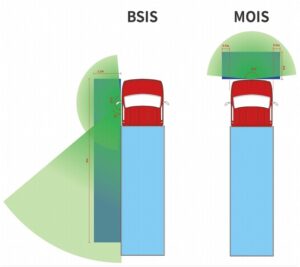From 28th October 2024, all HGVs operating in Greater London will need to install a Progressive Safe System (PSS) unless they have a three-star safety rating as part of the updated Direct Vision Standards (DVS).
DVS-COMPLIANT AI KITS FOR COMMERCIAL VEHICLE FLEETS


AI Camera PSS
AI Camera + Radar PSS


AI Radar PSS
KEY REQUIREMENTS OF THE PROGRESSIVE SAFE SYSTEM

- Moving Off Information System (MOIS) – fitted to the front of the vehicle to warn the driver of the presence of a vulnerable road user and prevent collisions at the front blind spot zone when a vehicle moves off from rest. The detection systems must not be activated by street furniture, or parked vehicles, must recognise vulnerable road users, and must activate to a range of 2 metres along the front of the vehicle, with driver alerts when the speed is between 0 and 5km/h (0 to 3mph).
- Blind Spot Information System (BSIS) – ensure full coverage down the nearside of the vehicle to detect vulnerable road users and prevent left turn collisions. The detection system must distinguish between vulnerable road users and roadside furniture or stationary vehicles. The detection range must be 2 metres in height, 2.2 metres to the side, and 9 metres to the back, as well as being active at all speeds up to 30 km/h (18 mph).
- Camera Monitoring System (CMS) – fitted to the nearside of the vehicle to eliminate the remaining blind spot at the nearside. A CMS can also be used as an alternative to fitting Class V and VI mirrors.
⦁ Moving Off Information System (MOIS) – fitted to the front of the vehicle to warn the driver of the presence of a vulnerable road user and prevent collisions at the front blind spot zone when a vehicle moves off from rest.
The detection systems must not be activated by street furniture, or parked vehicles, must recognise vulnerable road users, and must activate to a range of 2 metres along the front of the vehicle, with driver alerts when the speed is between 0 and 5km/h (0 to 3mph).
⦁ Blind Spot Information System (BSIS) – ensure full coverage down the nearside of the vehicle to detect vulnerable road users and prevent left turn collisions. The detection system must distinguish between vulnerable road users and roadside furniture or stationary vehicles.
The detection range must be 2 metres in height, 2.2 metres to the side, and 9 metres to the back, as well as being active at all speeds up to 30 km/h (18 mph).
⦁ Camera Monitoring System (CMS) – fitted to the nearside of the vehicle to eliminate the remaining blind spot at the nearside. A CMS can also be used as an alternative to fitting Class V and VI mirrors.
⦁ Audio Warnings – fitted to all vehicles, including those with left-hand drive to ensure all vehicles have the ability to warn vulnerable road users of an intended manoeuvre.
⦁ Warning Signage – requirements remain unchanged.
